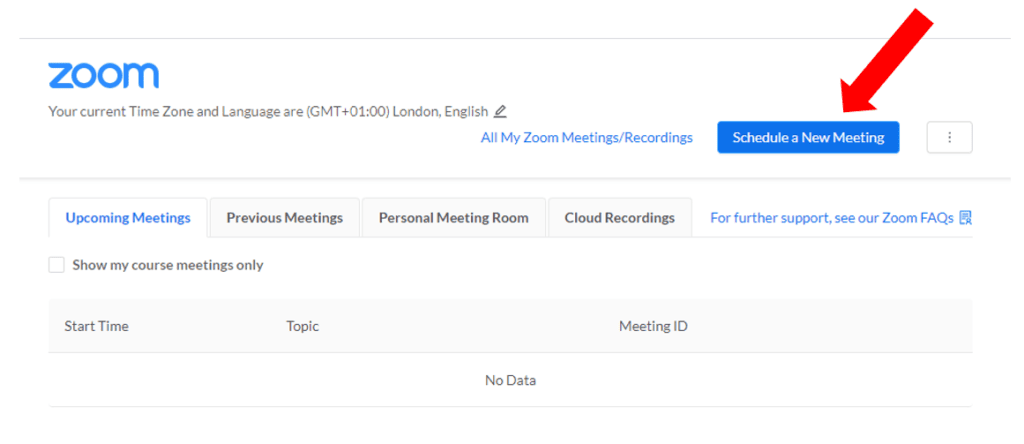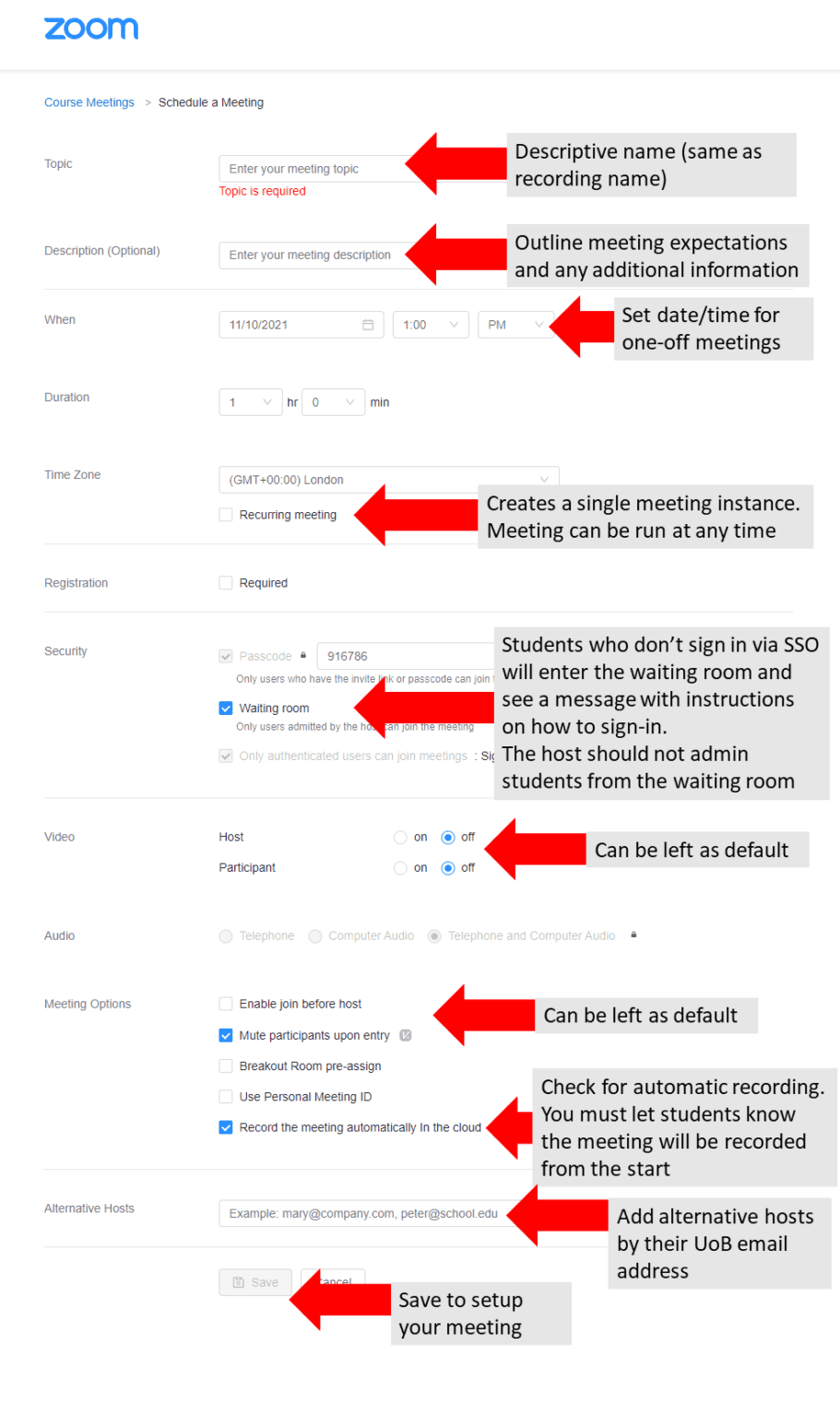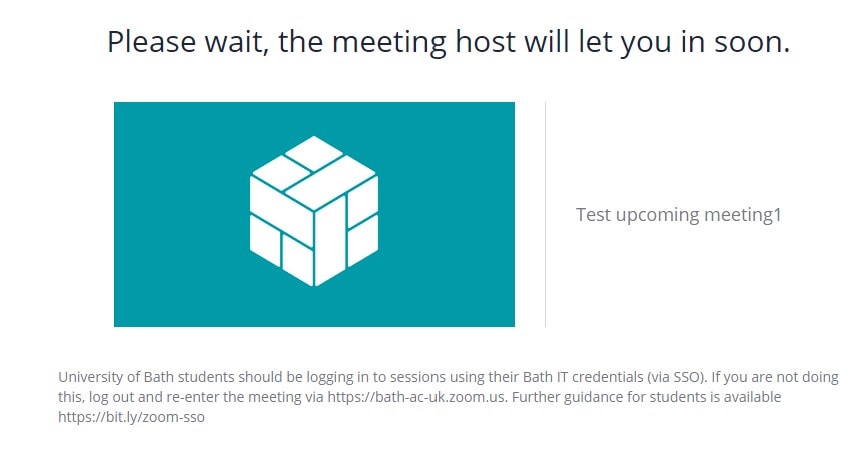Published on: 05/09/2023 · Last updated on: 05/08/2025
Zoom meetings for teaching
For teaching purposes, most meetings in Zoom should be scheduled using the Moodle/Zoom activity integration (See the next section). In some circumstances, you may also need to schedule standalone sessions. Guidance on how to do both is detailed below.
The maximum number of participants in a Zoom session at any one time is 500 (when scheduled by staff) and 300 (when scheduled by students).
You can create up to 100 breakout rooms. The maximum number of participants in a single breakout room depends on the meeting capacity, number of breakout rooms created, and if participants are assigned during the meeting or before the meeting.
For instructing your students to use Zoom, the following documents can be downloaded, and the PowerPoint file can be edited to suit your needs.
Scheduling a Zoom meeting via Moodle
The option to schedule a meeting for your Unit cohort, or a sub-group of the cohort, is possible from within Moodle, using the Zoom meeting activity. This ensures that students will have a single and consistent place to go to find their meeting links, and also saves the need to share meeting links with them individually. If you need to change the meeting settings after scheduling, we would recommend doing this on Zoom’s website. The settings will “flow” back down to Moodle. Further, meetings added via Moodle will automatically be added to the External tools activity block.
Please note you cannot restrict access to a specific group of students when scheduling Zoom meetings. Any student with the meeting ID will be able to join a Zoom meeting if they sign in with their Bath SSO. As such, if you are creating different meetings for different groups we recommend properly labelling your Zoom meetings and providing students clear instructions regarding different meeting links.
To schedule a meeting please follow the steps below:
- In your Moodle course, toggle Edit mode on using the toddle at the top of the page.
- In the appropriate section of your Moodle course, click on the ‘Add content’ plus symbol then click on ‘Activity or resource’.
- Select the Zoom activity.
- Give your Zoom meeting an Activity name, then click Save and return to course.
- Click the Zoom link that now appears in the course.
- Use the Zoom interface to Schedule a New meeting.

- Add a topic (meeting name), and optionally a description.
- Choose the time and date for the session. You should also specify the duration of the meeting (students will not be able to join after this duration has elapsed, but the meeting will not close if the session runs beyond this time, as long as the host is still present). Alternatively, you can create a recurring meeting to reuse the meeting link for subsequent meetings. A recurring meeting is recommended over creating multiple links with the same host and participants.
- Leave the remaining settings as they are set, unless you are using some of the additional functionality outlined below. We recommend these settings:
- Enable waiting room – Enabled. This ensures participants who are NOT using their Bath Zoom accounts will join a waiting room. Participants using their Bath Zoom accounts will not enter a waiting room.
- Enable join before host – Disabled. This ensures that only the host or alternative host can start the meeting.
- If you have alternative hosts you can add them at this stage. An Alternative Host will be able to start a meeting if required.
- Save your settings.
This image summarises the default settings when scheduling a Zoom meeting through Moodle:

Scheduling a standalone meeting
For teaching, we recommend you follow the guidance above and schedule sessions from the relevant Moodle course.
You can also schedule standalone meetings from within the web browser or from the Zoom client. Zoom offer extensive help guides. It is important to remember the following:
- All users accessing a meeting will need to have, as a minimum, a basic Zoom account to be able to join a session. University of Bath staff and students should have accounts linked to Single sign-on. Individuals joining a session from outside of the University will need to set up a basic (free) account to join a session if they do not already have one.
- We recommend that you set up your own meetings rather than delegating this process, or you may find that you are unable to access the meeting yourself.
- If you do delegate the set up of Zoom meetings, ensure that you refer to the scheduling privilege and alternative host information before doing this, and follow the guidance carefully.
Remember to press record if you want to keep a copy of your session. The recording will automatically be saved to your personal folder in Panopto.
Schedule a Meetings via Web Browser
Scheduling a meeting via web browser.
Scheduling a Meeting via Zoom Desktop App
Scheduling a Meeting via Zoom Desktop App.
Zoom Scheduler Settings
Below is further information on some of the Zoom scheduler settings, which you may want to customise when setting-up your Zoom meeting:
Adding Alternative Hosts
The Host of a Zoom meeting can specify an Alternative Host when setting up a meeting in Moodle. The Alternative Host needs to also be set up within Bath’s Zoom account and have logged into Zoom with their Bath SSO. Further information on what Alternative hosts can and cannot do is available on the Zoom Support Hub.
Only University of Bath members of staff with a registered Zoom account can be set as Alternative Hosts (i.e. not external persons).
Adding Alternative Hosts in Zoom.
Breakout Rooms
You can pre-assign participants to breakout rooms when you are scheduling your Zoom meeting. Please follow the instructions from Zoom support to pre-assign participants to the breakout rooms. You can either upload a CSV file containing University of Bath email addresses (abc@bath.ac.uk) or search by participant name (E.g. Jim Smith) as long as the participant is a registered Bath staff member or student.
Breakout rooms can also be created by the host after the meeting has started.
Recurring Meetings
You can set the option for a recurring meeting during set-up to make the meeting open-ended.
Waiting Rooms
Waiting rooms are enabled by default and we advise leaving this turned on.
- Once the meeting has started, participants who join using their University of Bath Zoom accounts will by-pass the waiting room.
- Participants who join using a non-University of Bath Zoom account will enter a waiting room and see the message below – ‘Please wait, the meeting host will let you in soon. University of Bath students should be logging in to sessions using their Bath IT credentials (via SSO).’

- The host will receive a pop-up notification telling them somebody is in the waiting room. The host can choose to admit the user(s) to the meeting. However, there is no way to know whether this participant is using their real name, is part of the unit of study or even if they are a student studying at Bath. Participants should only be admitted from the waiting room if the host is confident they should be in the meeting – normally this is only external guests from outside of the University who have been explicitly invited.

- Please impress upon your students that they should all be joining meetings using their University of Bath Zoom account. If they join a waiting room because they used a personal Zoom account, they should sign out of Zoom and join again using the correct account.
Importing a Zoom meeting into Moodle
A meeting created by you in the Zoom app or Zoom browser can be imported to your Moodle unit.
Watch this 2-minute video for guidance on importing a Zoom meeting into Moodle:
Importing and disassociating a Zoom meeting in Moodle.
Restrictions to importing a meeting:
- You cannot import a meeting ID created by another host.
- You cannot import the same meeting ID to more than 1 Moodle unit.
Scheduling a Zoom meeting on behalf of someone else
It is possible to have another member of staff, such as a Programme Administrator, schedule a meeting on your behalf. By scheduling the meeting for you the meeting will still have you as the host and you will retain host abilities, versus another member of staff scheduling a meeting for themselves and sharing the meeting link with you, as this will not give you hosting abilities.
The video below goes into more detail about different host roles and how to arrange Scheduler Privilege.